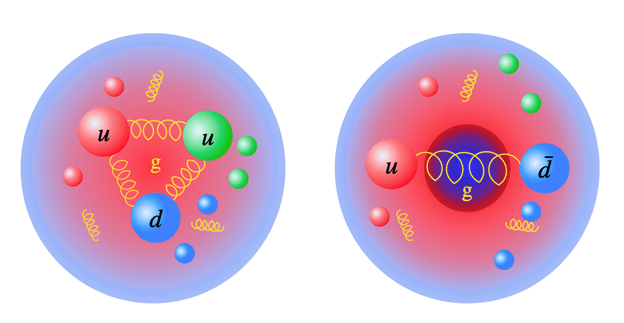Scientists have revealed how mass is distributed within two fundamental subatomic particles – the pion and the nucleon – through advanced numerical calculations. The research provides crucial insights that will guide future experiments at the Electron-Ion Collider (EIC), where scientists aim to better understand the origin of particle mass.
Journal: Physical Review D, May 2024 | Reading time: 4 minutes
Mapping Inner Structure
The study focused on a property called the trace anomaly, which helps keep quarks bonded together inside particles. Using first-principle calculations – starting from basic physical laws – researchers found that mass distribution patterns mirror charge distribution in these particles. In pions, the mass spreads similarly to a neutron’s charge, while in nucleons it resembles a proton’s charge pattern.
This mapping approach is similar to how X-ray diffraction revealed DNA’s structure. When electrons scatter off protons in experiments, they can produce heavy states that reveal the proton’s internal structure, particularly how gluons are distributed.
Experimental Applications
The calculations will help scientists interpret data from the future EIC at Brookhaven National Laboratory. These experiments will use electron-proton collisions to study how mass from quarks and gluons is distributed within protons.
The findings also suggest that pions play a special role in connecting two fundamental aspects of particle physics: the existence of an absolute scale and the asymmetry between left-handed and right-handed quantities in the Standard Model.
Future Research
While these results represent significant progress, the researchers note several areas needing further study. These include accounting for effects of unphysical sea quark mass, discretization in renormalization calculations, and finite-volume effects.
Glossary
- Hadron: Subatomic particle made of quarks, like protons and neutrons
- Quark: Fundamental particle that combines to form hadrons
- Gluon: Particle that carries the strong force binding quarks together
- Trace anomaly: Mathematical quantity related to particle mass and energy
- Standard Model: Theory describing fundamental particles and forces
Test Your Knowledge
1. How does the mass distribution in pions compare to charge distribution?
The mass distribution in pions is similar to the charge distribution pattern found in neutrons.
2. What facility will use these findings in future experiments?
The Electron-Ion Collider (EIC) at Brookhaven National Laboratory.
3. What technique do the calculations mirror from molecular biology?
X-ray diffraction, which was used to discover DNA’s structure.
4. What are two aspects of physics that pions help connect?
The existence of an absolute scale and the asymmetry between left-handed and right-handed quantities in the Standard Model.
Enjoy this story? Subscribe to our newsletter at scienceblog.substack.com
If our reporting has informed or inspired you, please consider making a donation. Every contribution, no matter the size, empowers us to continue delivering accurate, engaging, and trustworthy science and medical news. Independent journalism requires time, effort, and resources—your support ensures we can keep uncovering the stories that matter most to you.
Join us in making knowledge accessible and impactful. Thank you for standing with us!

